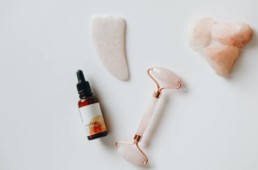
Complementary and alternative medicine has gone mainstream, and there are opportunities to include a variety of therapies in comprehensive treatment plans. This is particularly true of therapies associated with Traditional Chinese Medicine, as this discipline has been a trusted part of Chinese healthcare for thousands of years.
For example, many patients are exploring options such as herbal remedies, acupressure, acupuncture, and massage in addition to the medications and procedures available through standard Western medicine.
They are also pursuing movement techniques intended to build whole-body wellness and strengthen the connection between mind, body, and spirit. Examples include Tai Chi, Qigong, and some forms of yoga.
What is Gua Sha Scraping?
One of the lesser-known therapies, at least in the Western part of the world, is Gua Sha. Translated directly, Gua means “scrape” and Sha means “bruise”, “rash”, or “sand”. In other words, Gua Sha is the practice of scraping the skin in a way that may lead to light bruising.
The therapy is typically completed by a licensed Gua Sha practitioner, who begins by rubbing the skin with massage oil or another lubricant. With the help of a scraping tool, sometimes a smooth stone, spoon, or coin, the practitioner uses a comfortable amount of pressure to rub or scrape the surface of the skin in downward strokes.
It is most common for Gua Sha to be used on large parts of the body, such as the back, arms, legs, and buttocks. In some cases, it may be appropriate to treat the neck with Gua Sha, and some massage therapists offer a very gentle version for the face.
Though Westerners might find this practice puzzling, it is quite popular in other parts of the world. It is a common treatment throughout China, and it has expanded to other Asian countries like Vietnam and Cambodia.
What is Gua Sha Used For?
At first glance, one might wonder how Gua Sha can possibly have any health benefits. The answer is somewhat surprising.
Studies have shown that Gua Sha can effectively relieve stubborn muscle pain, such as chronic pain in the back and neck.
Some practitioners also recommend Gua Sha for conditions associated with other types of chronic pain, including fibromyalgia and arthritis. There have been successful applications of Gua Sha in the treatment of migraines, and research suggests Gua Sha may relieve symptoms of Tourette syndrome, Hepatitis B, and certain aspects of perimenopausal syndrome.
What are the Benefits of Gua Sha?
Traditional Chinese Medicine is built around the concept of Qi, the vital energy or life force that flows through all things. When Qi becomes blocked, depleted, or stagnant, the body’s systems are unable to function properly.
Gua Sha gets Qi flowing freely again by stimulating circulation just beneath the surface of the skin. Blockages preventing the flow of Qi are released, and stagnant Qi is prompted to resume its movement to all of the body’s organs and tissues.
Some practitioners believe that Gua Sha is effective, because it reduces inflammation in treated areas. Inflammation has been linked to chronic pain conditions, which explains why Gua Sha is particularly helpful in managing these symptoms.
Side Effects of Gua Sha
The goal of Gua Sha is to stimulate circulation, release toxins, and restore the flow of Qi.
To accomplish these objectives, practitioners intentionally use pressure on the Gua Sha tool to create light bruises or the red spots that are associated with petechiae. The tiny spots appear as a result of burst capillaries, and they tend to heal fairly quickly.
Aside from a change in the appearance of treated skin, some patients feel soreness or minor discomfort. However, when Gua Sha successfully relieves deeper body aches and pains, the surface-level skin discomfort is a welcome change.
Risks of Taking Gua Sha Treatments
Because Gua Sha is external stimulation of your skin, rather than an invasive procedure or drug therapy that you consume, there are very few risks associated with taking Gua Sha treatments.
However, that statement comes with a caveat. Gua Sha should only be performed by a certified Gua Sha therapist, as inexpert attempts at the therapy can lead to unnecessary discomfort, excessive bruising, and a failure to relieve the underlying health condition.
In very rare cases, Gua Sha has been associated with serious complications that are primarily related to tissue damage. In such cases, it is typically determined that an inexperienced practitioner used excessive force in performing the therapy on impacted patients.
For most patients, the biggest risk of Gua Sha is not the treatment itself, but the potential exposure to pathogens.
Tools used in Gua Sha therapy occasionally become contaminated with small amounts of blood. If they are not sterilized properly, there is the risk of transferring bloodborne pathogens between patients.
Again, you can avoid this type of risk by choosing a licensed Gua Sha practitioner. Experienced professionals ensure hospital-clean standards are met for each patient.
If you are seeking a licensed Gua Sha practitioner, begin by checking with a licensed acupuncturist. Often, these professionals are familiar with the practice, and if they don’t perform it themselves, they can refer you.
Alternatively, you can try a practitioner of Traditional Chinese Medicine, as this is one of many therapies associated with ancient Chinese wellness methods.
Who Should Not Take Gua Sha Treatments?
Gua Sha can be helpful in managing pain, but it isn’t an appropriate solution for everyone. For example, patients with skin conditions aren’t good candidates for Gua Sha, as it is specifically intended to create minute bruises and abrasions. For the same reason, Gua Sha isn’t recommended when patients have conditions that affect their veins, including deep vein thrombosis. Those who take blood thinning medication or otherwise bleed easily should also avoid Gua Sha.
Patients undergoing treatment for a wound that is still healing, an infection, or any sort of tumor should explore options other than Gua Sha. That same advice applies for patients with heart conditions requiring internal defibrillators, pacemakers, and so forth.
Is Gua Sha Good for Face Slimming?
Because Gua Sha is increasingly popular in the Western world, cosmeticians and beauty consultants are looking into how the practice might benefit their clients. Some have noticed that a gentle version of Gua Sha applied to the face promotes lymphatic drainage to enhance your overall appearance.
With regular treatments, skin begins to brighten as circulation improves over time. Some clients have noticed an increase in elasticity of their facial skin, which reduces the appearance of lines and wrinkles.
Gua Sha vs. Roller
If you plan to try a gentle version of Gua Sha at home, avoid use of sharper tools and heavy pressure. This deeper technique should only be attempted by certified Gua Sha professionals. Instead, apply gentle pressure using appropriate tools to increase circulation through light scraping.
Your Gua Sha tool is a bit different from your roller, which isn’t intended for the same type of massage. Rollers focus more on the surface of your skin, assisting with even application of oils and serums, as well as general relaxation of facial muscles.
Fortunately, you don’t have to decide between the two – there is a place for a jade Gua Sha tool and a roller in your skin care toolkit.
Getting Started with Gua Sha
Whether you want to add Gua Sha to your home beauty routine or use it to relieve symptoms of a medical condition, the first step is to find the right practitioner.
If your goal is to slim your face and brighten your skin, consult with an esthetician for instruction on the most effective Gua Sha techniques.
On the other hand, if you want the sort of Gua Sha treatment that is a staple in Traditional Chinese Medicine, identify a licensed practitioner that is fully certified in Gua Sha and guarantees hospital-clean standards for every treatment.
What’s Next?
About the author

